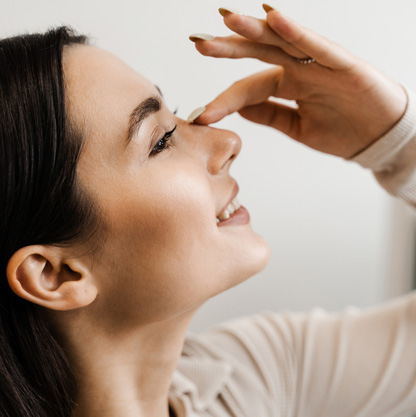
Our plastic surgeon, Dr. Karen Leong, has trained with some of the best rhinoplasty surgeons in the United States.
Dr. Leong appreciates the complexity of the nose and respects the many factors that can influence its structure — especially when it comes to repairing blocked airways.
What is a Septoplasty?
Septoplasty corrects a deviated septum, which is important to the structure of the nose. When you have bone or cartilage in your nose that is not straight, it can obstruct the airflow through the nasal passages. An obstructed airway can cause you to snore, develop sleep apnea, or have trouble breathing. Dr. Leong can straighten out the septum to improve these symptoms. During a private consultation at our office, she will examine your nose and discuss a plan of action for your treatment. While the aesthetic appearance is not the most important factor in a septoplasty, Dr. Leong will still consider what is best for your facial profile for a natural, pleasing result.


What Is a Septoplasty Procedure Like?
Our nose surgeries are performed as outpatient procedures under general anesthesia. With an incision made within the nostril, the tissue covering the septum will be lifted for a better view inside the nose. The bone and cartilage will be manipulated to restructure the nose as needed to improve the airway. Each patient will have his or her own customized treatment plan and details as to how to accomplish their septoplasty. When augmenting the support structures of the nose, Dr. Leong may need cartilage from deep within the nose or cartilage harvested from other body parts like the ears or ribs. The natural look of the nose will be preserved as much as possible. The incisions will be closed with sutures. There may also be splints placed inside the nose structure to help with alignment during the acute recovery period.
Recovery and Results After a Septoplasty
Following your surgery, you will need to go to all of your follow-up appointments with Dr. Leong. You will need to have the nasal splints taken out when the time is right. You can expect to have some swelling, bruising, and redness on your nose and around your eyes for several weeks post-op. Many patients report feeling congested after a septoplasty, which may be due to the pressure from the splints and gauze packing as well as from tissue swelling. This should subside once the splints and packing have been removed. You will be able to try out your newly opened nasal passages once the splints are no longer in place. If at any time you have a question or a concern (such as fever or infection) about your septoplasty, please contact Dr. Leong at our office as soon as possible.


Am I a Good Candidate for Septoplasty?
If you are wondering if you are a candidate for a septoplasty, we can provide you with a consultation. A septoplasty would be needed if you have a deviated or “crooked” nasal septum that is obstructing your airway or sinus functionality. You may have trouble with snoring, sleep apnea, chronic sinus ailments, or other nasal difficulties. You may also be a candidate if you were born with a nasal deformity or have had a traumatic injury to your nose with significant damage that complicates breathing.
There are many factors that go into the cost of a septoplasty. As each patient has his or her own customized treatment plan, the cost will be discussed in full detail at your consultation appointment.
If you are having difficulty breathing through a blocked nasal passage due to an abnormality in the structure of the nose, then a septoplasty can help alleviate some of the symptoms. In general, a patient will have this type of surgery to correct a medical problem, not an aesthetic concern. Many people who have a deviated septum love the shape of their nose and do not wish to change the appearance of their nose. Septoplasty can modify the features of your nose just slightly. This is dependent on how much cartilage is removed or if a graft is used to reconstruct the nose internally. While an ear, nose, and throat (ENT) doctor (an otolaryngologist) is capable of performing a septoplasty. The reason many patients go to a trusted plastic surgeon for a septoplasty is to make sure the surgery does not change their looks for the worse. The goal is not to enhance the nose for aesthetics but to make sure it still looks natural with very subtle modifications. Plastic surgeons, like Dr. Leong, are highly trained to preserve the look and shape of the nose while also improving its form and functionality.
Most patients have trouble breathing because a percentage of their nasal passage is blocked. However, most of the time, a deviated septum is asymptomatic, which means it is not getting worse or causing the patient concern. It is hard to answer this question without seeing the condition of the nose. If you find yourself with a hole (septal perforation) for any reason, it is important to keep a watchful eye on the size of the hole’s opening. A perforation can become a nasal structural problem if it continues to get larger. You should see an experienced plastic surgeon for a repair if this is the case.
If you were born with a deviated septum, the symptoms ordinarily worsen with age. You may have experienced a trauma to the nose that caused the condition, such as a car accident or a sports injury. There are many people living with an untreated deviated septum. The symptoms generally have to be severe to warrant surgical intervention.





